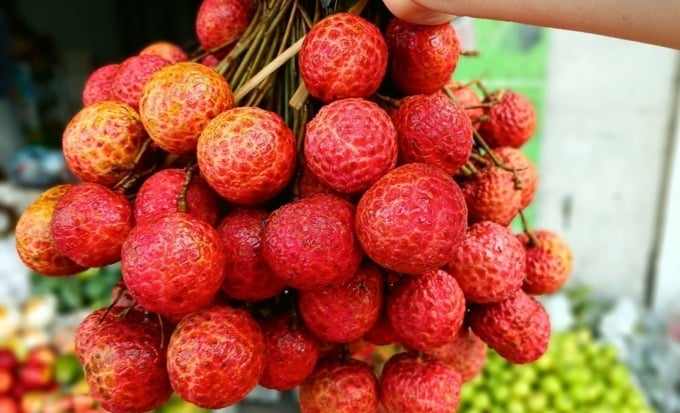November 27, 2025 | 13:12 GMT +7
November 27, 2025 | 13:12 GMT +7
Hotline: 0913.378.918
November 27, 2025 | 13:12 GMT +7
Hotline: 0913.378.918

Lychees at a fruit shop on Le Duc Tho Street (Go Vap District) in May 2024. Photo: Thi Ha.
The General Department of Viet Nam Customs has just announced data on lychee export in the first half of this year, showing that the export turnover reached USD 23.6 million, down 46% compared to the same period last year. Of which, China - the largest market for Vietnamese lychees - recorded the sharpest decrease (62%) in the top 10 import markets, followed by Japan and the UK with decreases of nearly 4% and 16%, respectively.
According to the Vietnam Fruit and Vegetable Association, the main reason for this decline is that the supply of lychees this year has decreased sharply due to crop failures in gardens.
Data from localities shows that lychee output in 2024 will only reach about 200,000 tons, down 50% compared to the previous year. Specifically, Bac Giang harvested about 100,000 tons (down 50% compared to 2023), and Hai Duong reached about 45,000 tons (down 23%)...
Mr. Le Ba Thanh, Deputy Director of the Department of Agriculture and Rural Development of Bac Giang, said that there has never been a year with such a severe lychee crop failure as this year. By the end of June, Bac Giang had consumed more than 85,700 tons of lychees, of which early-ripening varieties accounted for more than 47,600 tons.
Due to the crop failure, the price of lychees this season has increased to a record high. In the domestic market, each kilogram of traditional lychees at the end of the season is up to VND 180,000, while in the same period last year, it was only VND 40,000- VND 60,000. Hybrid lychees such as white and pink eggplant have retail prices of up to VND 360,000 per kilogram. Unlike previous years, this year, the main crop, lychees, only appeared sporadically in the South, with some supermarket chains selling them for less than a month.
Lychee is one of the famous fruits of Vietnam, harvested from April to June. Major growing areas are Thanh Ha (Hai Duong province) and Luc Ngan (Bac Giang province). In addition, the Central Highlands and Hung Yen have also been developing this tree.
Translated by Huong Giang

(VAN) China’s cooking oil is suddenly flooding into India. It all comes down to a soybean surplus that Beijing doesn’t quite know what to do with.

(VAN) An Giang promotes supply-demand connections, standardizes quality and builds value chains, creating a foundation for sustainable bird’s nest development and aiming to expand exports.
/2025/11/24/5339-4-nongnghiep-075331.jpg)
(VAN) Recently, the conference on 'Sustainable Fisheries Linkage Chain - Tilapia for Export' took place in Tien Hai commune, Hung Yen province.
/2025/11/21/4309-2-153400_128.jpg)
(VAN) Green and low-emission rice is paving the way for Vietnamese rice to enter high-end markets, marking the beginning of a transformation journey toward greening and elevating the national rice brand.

(VAN) ‘Right to Win’ outlines a national action plan that shapes a new vision for Viet Nam’s agriculture in an era of renewal and global integration.

(VAN) Lam Dong’s farmed sturgeon output this year is expected to reach 2,300 tons, worth VND 450 billion, affirming the brand’s position on the market.

(VAN) A surge in Ukrainian egg exports, largely driven by soaring sales to the UK over the last few years, has notably pushed up egg prices on the domestic market.